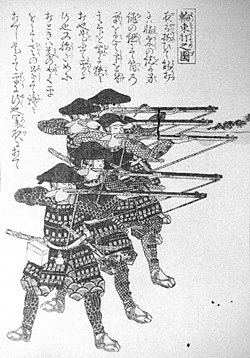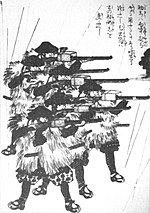
Ashigaru wearing armor and jingasa firing tanegashima (Japanese matchlocks).
Ashigaru (足軽 lit. lightfeet) were foot-soldiers who were employed by the samurai class of feudal Japan. The first known reference to ashigaru was in the 1300s,[1] but it was during the Ashikaga Shogunate-Muromachi period that the use of ashigaru became prevalent by various warring factions.[2]
Origins[]
Attempts were made in Japan by the Emperor Tenmu(673-86) to have a conscripted national army, but this did not come about and by the 10th century Japan instead relied on individual land owners to provide men for conflicts and wars. These horse owning land owners were the beginnings of the samurai class and the men who worked the land for the land owners became the common foot soldiers during times of war. These foot soldiers could have long ties and loyalty to the land owners which went back many generations.[3]
Land-owning samurai, together with peasant foot soldiers, fought in many wars and conflicts including the Mongol invasions of Japan in 1274 and 1281. Constant warfare between the 1300s and 1500s made the hiring of foot soldiers with no particular loyalty necessary at times. Paid only in loot, these mercenaries were not well-trained and thus could not always be depended upon in battle. Nonetheless, these wandering foot soldiers would eventually become the ashigaru.[4]
Weapons and armour[]

A plain undecorated Tanegashima, this type was used by the ashigaru.
Ashigaru were commonly armed with naginata, yari, yumi and swords.[5] In Japan. Ashigaru armour varied depending on the period, from no armour to heavily armored and could consist of conical hats called jingasa made of lacquered hardened leather or iron, chest armor (dou or dō), helmets (kabuto), armoured hoods (tatami zukin), armored sleeves (kote), shin protection (suneate), and thigh protection (haidate).
The warfare of the Sengoku period (15th and 16th centuries) required large quantities of armour to be produced for the ever growing armies of ashigaru. Simple munition quality (okashi or lent)[6] chest armours (dou or dō) and helmets (kabuto) were mass produced including tatami armours which could be folded or were collapsible.[7]Tatami armours were made from small rectangular (karuta) or hexagon (kikko) armour plates that were usually connected to each other by chain armour (kusari) and sewn to a cloth backing.[8] In the 16th century the ashigaru were also armed with matchlocks of the type known as tanegashima.[9][10] Small banners called sashimono could be worn on their backs during battle for identification.[11]
Service in war[]

A group of re-enactors portraying ashigaru march in the Ieyasu parade in remembrance of the Battle of Sekigahara.
In the Ōnin War, ashigaru gained a reputation as unruly troops when they looted and burned Miyako (modern-day Kyoto). In the following Sengoku period the aspect of the battle changed from samurai's man-to-man fight to ashigaru's group combat. Therefore, ashigaru became the main force of battles and some of them rose to greater prominence. Those who were given control of ashigaru were called ashigarugashira (足軽頭) The most famous of them was Toyotomi Hideyoshi, who also raised many of his warrior followers to samurai status. Yamauchi Katsutoyo was one of such samurai and later daimyo who rose from ashigaru.
New weapons and new tactics[]

Edo period print of ashigaru wearing mino rain capes and jingasa in the rain while firing tanegashima (Japanese matchlocks).
Ashigaru formed the backbone of samurai armies in the later periods. The real change for the ashigaru began in 1543 with the introduction of matchlock firearms by the Portuguese. Almost immediately local daimyo started to equip their ashigaru with the new weapon that required little training to use proficiently, as compared to the yumi (Japanese bow) which took many years to learn. As battles became more complex and forces larger, ashigaru were rigorously trained so that they would hold their ranks in the face of enemy fire.
The advantage of the new powerful ranged weapon proved decisive to samurai warfare. This was demonstrated at the Battle of Nagashino in 1575, where carefully positioned ashigaru with tanegashima (Japanese matchlocks) thwarted Takeda's repeated heavy cavalry charges against the Oda clan's defensive lines and broke the back of the Takeda war machine.
After the battle, the ashigarus' role in the armies were cemented as a very powerful complement to the samurai. The advantage was used in the two invasions of Korea in 1592 and 1597 against the Koreans and later the Chinese. Though the ratio of the guns (matchlocks) and the bows was 2:1 at the first invasion the ratio became 4:1 at the second invasion since the guns were very effective .[12]
Discontinuation of conscription[]
Following the rise of the Tokugawa Shogunate the conscription of ashigaru fell into disuse. Since ashigaru's change to the professional soldier was advanced after Oda Nobunaga, the ashigaru separated from the farmer gradually. When entering the Edo period, the ashigaru's position was fixed and the use of conscripts was abandoned for over two hundred years in Japan. Ashigaru were considered to be of the samurai class in some han (domains) and but not in others.[13]
Gallery[]
References[]
- ↑ Warriors of Medieval Japan, Stephen Turnbull, Osprey Publishing, 2007 p.99
- ↑ War in the early modern world, Jeremy Black, Taylor & Francis, 1999 p.59
- ↑ Ashigaru 1467-1649, Stephen Turnbull, Howard Gerrard, Osprey Publishing, 2001 p.5-6
- ↑ Ashigaru 1467-1649, Stephen Turnbull, Howard Gerrard, Osprey Publishing, 2001 p.5-6
- ↑ War in the early modern world, Jeremy Black, Taylor & Francis, 1999 p.59
- ↑ The Watanabe Art Museum Samurai Armour CollectionVolume I ~ Kabuto & Mengu, Trevor Absolon P.130
- ↑ Samurai: The Weapons and Spirit of the Japanese Warrior, Clive Sinclaire, Globe Pequot, 2004 P.29
- ↑ Samurai 1550-1600, Anthony J. Bryant, Angus McBride, Osprey Publishing, 1994 P.31
- ↑ Ashigaru 1467-1649, Stephen Turnbull, Howard Gerrard, Osprey Publishing, 2001 p.17-18
- ↑ The samurai: warriors of medieval Japan, 940-1600, Anthony J. Bryant, Angus McBride, Osprey Publishing, 1989 p.63
- ↑ Ashigaru 1467-1649, Stephen Turnbull, Howard Gerrard, Osprey Publishing, 2001 p.6
- ↑ "War history of Japan: Chousen-eki (日本戦史 朝鮮役)"(1924) Staff headquarters of Imperial Japanese Army /ISBN 4-19-890265-8
- ↑ Samurai Armies 1467-1649, Author Stephen Turnbull, Publisher Osprey Publishing, 2008, ISBN 1846033519, 9781846033513 P.88
External links[]
| Wikimedia Commons has media related to Ashigaru. |
| |||||||||||||||||||||||||||||||||||||||||||||||
The original article can be found at Ashigaru and the edit history here.






